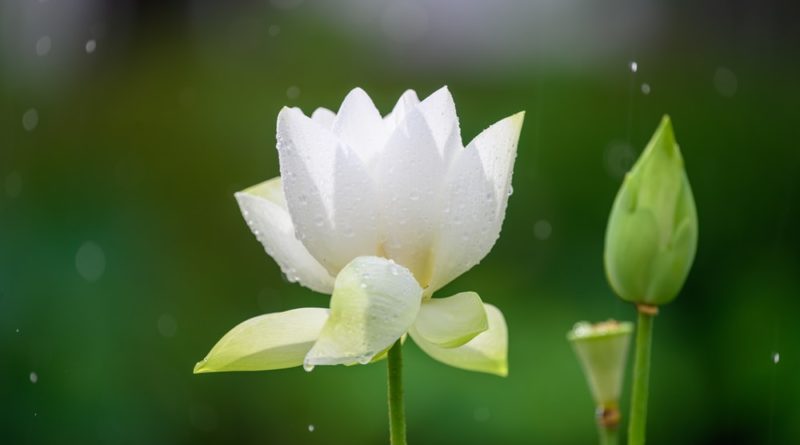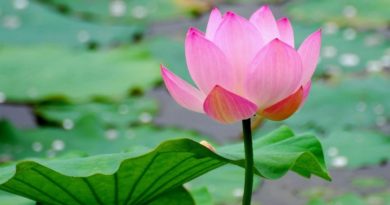THE BASIC METHOD OF MEDITATION – PART III
THE BASIC METHOD OF MEDITATION – PART III
“Do absolutely nothing and see how smooth and beautiful and timeless the breath can appear.”
Parts 1 and 2 describe the first four stages (as they are called here) of meditation. These are:
– Present moment awareness;
– Silent awareness of the present moment;
– Silent present moment awareness of the breath; and
– Full sustained attention on the breath.
Each of these stages needs to be well developed before going in to the next stage. When one rushes through these “stages of letting go”, then the higher stages will be unreachable. It is like constructing a tall building with inadequate foundations. The first storey is built quickly and so is the second and third storey. When the fourth storey is added, though, the structure begins to wobble a bit. Then when they try to add a fifth storey, it all comes tumbling down. So please take a lot of time on these four initial stages, making them all firm and stable, before proceeding on to the fifth stage. You should be able to maintain the fourth stage, “full sustained attention on the breath”, aware of every moment of the breath without a single break, for two or three hundred breaths in succession with ease. I am not saying to count the breaths during this stage, but I am giving an indication of the sort of time interval that one should remain with stage four before proceeding further. In meditation, patience is the fastest way!
The fifth stage is called “full sustained attention on the beautiful breath“. Often, this stage flows on naturally, seamlessly, from the previous stage. As one’s full attention rests easily and continuously on the experience of breath, with nothing interrupting the even flow of awareness, the breath calms down. It changes from a coarse, ordinary breath, to a very smooth and peaceful “beautiful breath”. The mind recognizes this beautiful breath and delights in it. The mind experiences a deepening of contentment. It is happy just to be there watching this beautiful breath. The mind does not need to be forced. It stays with the beautiful breath by itself. “You” don’t do anything. If you try and do something at this stage, you disturb the whole process, the beauty is lost and, like landing on a snake’s head in the game of snakes and ladders, you go back many squares. The “doer” has to disappear from this stage of the meditation on, with just the “knower” passively observing.
A helpful trick to achieve this stage is to break the inner silence just once and gently think to yourself: “Calm!”. That’s all. At this stage of the meditation, the mind is usually so sensitive that just a little nudge like this causes the mind to follow the instruction obediently. The breath calms down and the beautiful breath emerges.
When you are passively observing just the beautiful breath in the moment, the perception of “in” (breath) or “out” (breath), or beginning or middle or end of a breath, should all be allowed to disappear. All that is known is this experience of the beautiful breath happening now. The mind is not concerned with what part of the breath cycle this is in, nor on what part of the body this is occurring. Here we are simplifying the object of meditation, the experience of breath in the moment, stripping away all unnecessary details, moving beyond the duality of “in” and “out”, and just being aware of a beautiful breath which appears smooth and continuous, hardly changing at all.
Do absolutely nothing and see how smooth and beautiful and timeless the breath can appear. See how calm you can allow it to be. Take time to savour the sweetness of the beautiful breath, ever calmer, ever sweeter.
Now the breath will disappear, not when “you” want it to but when there is enough calm, leaving only “the beautiful”. A simile from English literature might help. In Lewis Carrol’s “Alice in Wonderland”, Alice and the Red Queen saw a vision of a smiling Cheshire cat appear in the sky. As they watched, first the cat’s tail disappeared, then its paws followed by the rest of its legs. Soon the Cheshire cat’s torso completely vanished leaving only the cat’s head, still with a smile. Then the head started to fade into nothing, from the ears and whiskers inwards, and soon the smiling cat’s head had completely disappeared — except for the smile which still remained in the sky! This was a smile without any lips to do the smiling, but a visible smile nevertheless. This is an accurate analogy for the process of letting go happening at this point in meditation. The cat with a smile on her face stands for the beautiful breath. The cat disappearing represents the breath disappearing and the disembodied smile still visible in the sky stands for the pure mental object “beauty” clearly visible in the mind.
This pure mental object is called a Nimitta. “Nimitta” means “a sign”, here a mental sign. This is a real object in the landscape of the mind (citta) and when it appears for the first time it is extremely strange. One simply has not experienced anything like it before. Nevertheless, the mental activity called “perception” searches through its memory bank of life experiences for something even a little bit similar in order to supply a description to the mind. For most meditators, this “disembodied beauty”, this mental joy, is perceived as a beautiful light. It is not a light. The eyes are closed and the sight consciousness has long been turned off. It is the mind consciousness freed for the first time from the world of the five senses. It is like the full moon, here standing for the radiant mind, coming out from behind the clouds, here standing for the world of the five senses. It is the mind manifesting, not a light, but for most it appears like a light, it is perceived as a light, because this imperfect description is the best that perception can offer.
For other meditators, perception chooses to describe this first appearance of mind in terms of physical sensation, such as intense tranquillity or ecstasy. Again, the body consciousness (that which experiences pleasure and pain, heat and cold, and so on) has long since closed down and this is not a physical feeling. It is just “perceived” as similar to pleasure. Some see a white light, some a gold star, some a blue pearl…the important fact to know is that they are all describing the same phenomena. They all experience the same pure mental object and these different details are added by their different perceptions.
You can recognize a nimitta by the following 6 features:
1) It appears only after the 5th stage of the meditation, after the meditator has been with the beautiful breath for a long time;
2) It appears when the breath disappears;
3) It only comes with the external five senses of sight, hearing, smell, taste and touch are completely absent;
4) It manifests only in the silent mind, when descriptive thoughts (inner speech) are totally absent;
5) It is strange but powerfully attractive; and
6) It is a beautifully simple object.
I mention these features so that you may distinguish real nimittas from imaginary ones.
The sixth stage, then, is called “experiencing the beautiful nimitta“. It is achieved when one lets go of the body, thought, and the five senses (including the awareness of the breath) so completely that only the beautiful nimitta remains.
Sometimes when the nimitta first arises it may appear “dull”. In this case, one should go immediately back to the previous stage of the meditation, continuous silent awareness of the beautiful breath. One has moved to the nimitta too soon. Sometimes the nimitta is bright but unstable, flashing on and off like a lighthouse beacon and then disappearing. Again this shows that you have left the beautiful breath too early. One must be able to sustain one’s attention on the beautiful breath with ease for a long, long time before the mind is capable of maintaining clear attention on the far more subtle nimitta. So train the mind on the beautiful breath, train it patiently and diligently, then when it is time to go on to the nimitta, it is bright, stable and easy to sustain.
The main reason why the nimitta can appear dull is that the depth of contentment is too shallow. You are still “wanting” something. Usually, you are wanting the bright nimitta or you are wanting Jhāna. Remember, and this is important, Jhānas are states of letting go, incredibly deep states of contentment. So give away the hungry mind, develop contentment on the beautiful breath and the nimitta and Jhāna will happen by themselves.
The main reason why the nimitta is unstable is because the “doer” just will not stop interfering. The “doer” is the controller, the back seat driver, always getting involved where it does not belong and messing everything up. This meditation is a natural process of coming to rest and it requires “you” to get out of the way completely. Deep meditation only occurs when you really let go, and this means REALLY LET GO to the point that the process becomes inaccessible to the “doer”.
A skilful means to achieve such profound letting go is to deliberately offer the gift of confidence to the nimitta. Interrupt the silence just for a moment, so so gently, and whisper as it were inside your mind that you give complete trust to the nimitta, so that the “doer” can relinquish all control and just disappear. The mind, represented here by the nimitta before you, will then take over the process as you watch it all happen.
You do not need to do anything here because the intense beauty of the nimitta is more than capable of holding the attention without your assistance. Be careful, here, not to go assessing. Questions such as “What is this?”, “Is this Jhāna?”, “What should I do next?”, and so on are all the work of “the doer” trying to get involved again. This is disturbing the process. You may assess everything once the journey is over. A good scientist only assesses the experiment at the end, when all the data are in. So now, do not assess or try to work it all out. There is no need to pay attention to the edge of the nimitta “Is it round or oval?”, “Is the edge clear or fuzzy?”. This is all unnecessary and just leads to more diversity, more duality of “inside” and “outside”, and more disturbance.
Let the mind incline where it wants, which is usually to the centre of the nimitta. The centre is where the most beautiful part lies, where the light is most brilliant and pure. Let go and just enjoy the ride as the attention gets drawn into the centre and falls right inside, or as the light expands all around enveloping you totally. This is, in fact, one and the same experience perceived from different perspectives. Let the mind merge in the bliss. Let the seventh stage of this path of meditation, First Jhāna, occur.
There are two common obstacles at the door into Jhāna: exhilaration and fear. Exhilaration is becoming excited. If, at this point, the mind thinks “Wow, this is it!” then the Jhāna is most unlikely to happen. This “Wow” response needs to be subdued in favour of absolute passivity. You can leave all the “Wows” until after emerging from the Jhāna, where they properly belong. The more likely obstacle, though, is fear. Fear arises at the recognition of the sheer power and bliss of the Jhāna, or else at the recognition that to go fully inside the Jhāna, something must be left behind — You! The “doer” is silent before Jhāna but still there. Inside Jhāna, the “doer” is completely gone. The “knower” is still functioning, you are fully aware, but all the controls are now beyond reach. You cannot even form a single thought, let alone make a decision. The will is frozen, and this can appear scary to the beginner. Never before in you whole life have you ever experienced being so stripped of all control yet so fully awake. The fear is the fear of surrendering something so essentially personal as the will to do.
This fear can be overcome through confidence in the Buddha’s Teachings together with the enticing bliss just ahead that one can see as the reward. The Lord Buddha often said that this bliss of Jhāna “should not be feared but should be followed, developed and practised often” (Latukikopama Sutta, Majjhima Nikāya). So before fear arises, offer your full confidence to that bliss and maintain faith in the Lord Buddha’s Teachings and the example of the Noble Disciples. Trust the Dhamma and let the Jhāna warmly embrace you for an effortless, body-less and ego-less, blissful experience that will be the most profound of your life. Have the courage to fully relinquish control for a while and experience all this for yourself.
If it is a Jhāna it will last a long time. It does not deserve to be called Jhāna if it lasts only a few minutes. Usually, the higher Jhānas persist for many hours. Once inside, there is no choice. You will emerge from the Jhāna only when the mind is ready to come out, when the “fuel” of relinquishment that was built up before is all used up. These are such still and satisfying states of consciousness that their very nature is to persist for a very long time. Another feature of Jhāna is that it occurs only after the nimitta is discerned as described above. Furthermore, you should know that while in any Jhāna it is impossible to experience the body (e.g. physical pain), hear a sound from outside or produce any thought, not even “good” thoughts. There is just a clear singleness of perception, an experience of non-dualistic bliss which continues unchanging for a very long time. This is not a trance, but a state of heightened awareness. This is said so that you may know for yourself whether what you take to be a Jhāna is real or imaginary.
There is much more to meditation, but here only the basic method has been described using seven stages culminating with the First Jhāna. Much more could be said about the “five hindrances” and how they are overcome, about the meaning of mindfulness and how it is used, about the Four Satipatthāna and the Four Roads to Success (Iddhipāda) and the Five Controlling Faculties (Indriya) and, of course, about the higher Jhānas. All these concern this practice of meditation but must be left for another occasion.
For those who are misled to conceive of all this as “just Samatha practice” without regard to Insight (Vipassanā), please know that this is neither Vipassanā nor Samatha. It is called “Bhāvanā“, the method taught by the Lord Buddha and repeated in the Forest Tradition of N.E. Thailand of which my teacher, Ven. Ajahn Chah, was a part. Ajahn Chah often said that Samatha and Vipassanā can not be separated, nor can the pair be developed apart from Right View, Right Thought, Right Moral Conduct and so forth. Indeed, to make progress on the above seven stages, the meditator needs an understanding and acceptance of the Lord Buddha’s Teachings and one’s precepts must be pure. Insight will be needed to achieve each of these stages, that is insight into the meaning of “letting go”. The further one develops these stages, the more profound will be the insight, and if you reach as far as Jhāna then it will change your whole understanding. As it were, Insight dances around Jhāna and Jhāna dances around Insight. This is the Path to Nibbāna, for the Lord Buddha said, “for one who indulges in Jhāna, four results are to be expected: Stream Winner, Once Returner, Non Returner or Arahant” (Pāsādika Sutta, Dīgha Nikāya).









